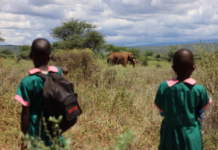By Winnie Kamau

Scientists attribute the swelling of the Lakes in the Great Rift Valley to a new phenomenon which occurs every 60 years. According to Edward Njagi , Ichthyologist (Studies fish) from National Museums of Kenya who notes that in the past we used to receive little rainfall until government came in and put in measures “There’s been major reduction in logging of trees and has made the situation better, so rivers that never used to bring water now do as most rivers emanate from Mau water tower”.

According to the Scientists the new phenomenon which needs further investigation recurs every 60 years. Njagi explains “The Phenomenon recurs every 60 years. It begins with shrinking of the lakes then after gradually swells” Njagi adds “Lake Nakuru 60 years back it swelled and shrunk again and now it has swelled again” this phenomenon has baffled Scientists dealing with Wetlands and are working on more investigations. Climate change has not been left behind as one of the probable cause of investigation as Kenya continues experiencing erratic weather patterns.
A recent tour showed the harsh reality of how a once beautiful park has been swallowed. If you have ever been to the park before you will think it’s almost a ghost of its former self.
The shock was when we saw the abandoned Kenya Wildlife Services (KWS) gates, bandas and structures swallowed up by the Lake. Torrents of questions were poured on our guide Patrick Wadenge who is a warden of the Park for over close to two decades who attributed the swelling to the Government’s push to rehabilitate the Mau Complex, “The Government has put measures stopping the forest cover harvesting of Mau complex is the reason for the swelling of Lake Nakuru” he says. Lake Nakuru measures around 44 Sq Km since the swelling it has risen to 46 Sq Km making a huge difference in the Park.
Lake Nakuru is one of the Rift Valley soda lakes located on the floor of the Great Rift. Lake Nakuru , which is a Ramsar site , is derived from the Maasai word dusty is protected under the Nakuru National Park which is famed mainly for the huge numbers of flamingos which are a rare wading bird species. But all’s not well in this park as for the last three years the swelling of the Lake has disrupted the ecosystem of this famous Flamingo Lake.
The Flamingos have been a huge tourist attraction in Lake Nakuru. But due to the increased levels of water in the Lake have led to the decreased amounts of the blue-green algae found in salty waters which is fed on by the Flamingos. this has led to the relocation of the largest population of Flamingos to Lake Bogoria one of the other Lakes in the Rift. Lake Natron which is one of the many border Lakes between Kenya and Tanzania has always been a high breeding ground for the Lesser Flamingo species which are only found in North West India and at the Great Rift Valley.
Kenya has six designated Ramsar sites in the Great African Rift Valley, lakes Naivasha, Elementaita, Nakuru, Bogoria, Baringo and Tana Delta; providing enhanced tourism, employment for Kenya’s tourism sector, vibrant horticultural industry around Lake Naivasha and steam geysers in Lake Bogoria.
The Ramsar Convention on wetlands is an intergovernmental treaty that embodies the commitments of its member countries to maintain the ecological character of their wetlands by providing a framework for national action and international cooperation for the conservation and wise use of these fragile ecosystems and their resources.
Wadenge says the swollen Lake has really affected tourism at the Lake “It is a big blow to Lake Nakuru which has caused food for the Flamingo to disappear and lengthened the park route for Visitors.”

Other effects felt by the swelling Lakes is the biodiversity which has led to the displacement of the animals. Farming activities along the river banks has increased leading to eutrophication of the waters with sedimentation, pesticides and chemicals are washed into the rivers from the farms affecting the aquatic life.
The heavy metals drained into the rivers and to the Lakes are not digested by the fish hence they are transferred directly into our bodies. The swelling has caused human -wildlife conflict especially around Lake Nakuru where the Hippos in their quest to look for grazing land wander off to human settlements.
The impact of climate change is being felt in the rising temperatures in the atmosphere and in turn affects the temperatures in the water and thus affecting the survival of fish Njagi explains “Climate change affects the fish though they adjust very easily as hot weather temperature rises like Tilapia survives between 18°C – 30°C” adding “High temperatures affect dissolved oxygen which fish rely on to absorb in their gills which in turn affects the Biological Oxygen demand”.

When the Biological oxygen demand changes the fish strains and it does have a huge impact on feeding and the feeding levels come down or they end up overfeeding.
Njagi whose whole career is centered on the studying fish in the whole country is able to tell you how many water bodies are in Kenya and what kind of species of fish are in in each including Lakes, Dams Rivers and the Ocean. At the National Museums of Kenya (NMK) where Njagi’s office is located he has georeferenced data on fish and are currently working on an online data system that will be soon available to the public.
Njagi also notes “With little resources for the fish in the water leads to an increase of reproduction”. As Wadenge holds on to hope that the Lake will recede and go back to normal levels, Scientists continue investigating this great Phenomenon that explains the 60 year swelling of the Lakes in the Rift Valley.














